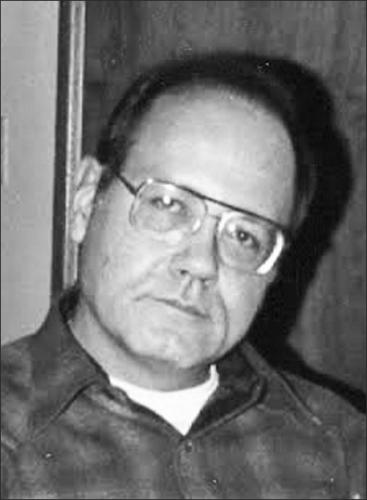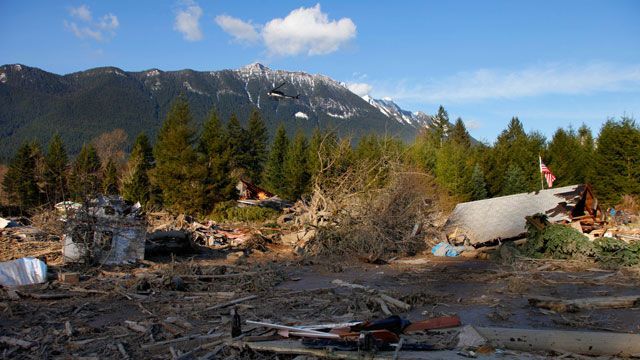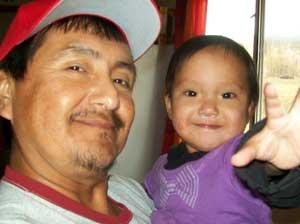Author: Kim Kalliber
Gov. Inslee, Red Cross, Arlington community respond to Oso landslide
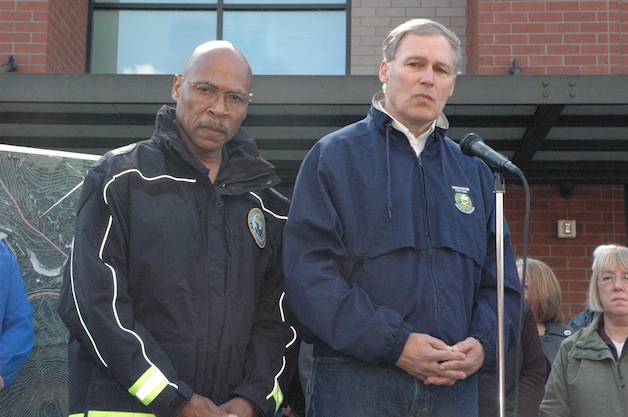
— image credit: Kirk Boxleitner
Kirk Boxleitner, Arlington Times
ARLINGTON — Washington state Gov. Jay Inslee joined fellow elected officials from the federal to the local levels at the Arlington Police Station on Sunday, March 23, to address the landslide in Oso on Saturday, March 22, that’s since blocked both State Route 530 and the North Fork of the Stillaguamish River, even as the surrounding community continues to respond in its own ways.
“We always plan for things that we hope will never happen,” said Snohomish County Executive John Lovick, before he introduced not only Inslee, but also U.S. Sen. Patty Murray and U.S. Rep. Susan DelBene. “This is an example of how we have planned, and why it is so wonderful that we have such a great, functioning government in not only Washington state, but also Snohomish County.”
“Olympia is the state capitol of Washington, but today, Oso is the heart of the state of Washington,” Inslee said. “It is a small community of only 200-plus people, but there are six and a half million Washingtonians who, at this moment, are embracing them with our arms and our prayers.”
Inslee called upon his fellow Washington residents to extend aid to a community that had previously managed to remain self-sufficient in relative isolation. Although he was pleased to confirm that at least seven people had been rescued from the site to date, he was nonetheless struck by the scope of the landslide’s impact while flying over the area only an hour before.
“The devastation is just unrelenting and awesome,” Inslee said of the landslide, whose confirmed death toll stands at four so far. “There really is no stick standing in the path of the slide, and it is a reminder that we live in powerful forces of nature, but there is another powerful force of nature, and that is empathy, and compassion, and helping these families who are both grieving and now awaiting words of their loved ones.”
Inslee twice declined to offer any predictions as to when State Route 530 might reopen, but repeatedly pledged that the currently ongoing search and rescue efforts would continue.
“All possible assets that could be beneficial, anywhere, have been brought to bear in this, both from the air and on the ground,” said Inslee, who noted that those assets include both helicopters and hovercraft.
Although the Snohomish County Department of Emergency Management lifted its evacuation order, Inslee asked those downstream of the landslide on the Stillaguamish River to retain “a heightened state of awareness,” advice that was later echoed by Chad Buechler, an American Red Cross volunteer at Post Middle School, which housed 27 overnight occupants from the evening of March 22 through the morning of March 23.
Murray echoed Inslee’s sympathies for both the victims of the landslide and their surviving loved ones, before she commended the first responders to this disaster for their efforts.
“The response to this has been incredible,” Murray said. “People are putting their own lives at risk in the search and rescue efforts. Every single person in these communities — local, state, federal — has been working really hard to make sure that they could do everything they can in this incident.”
Murray pledged that needed federal resources will be made available, and was joined by DelBene in praising Arlington Mayor Barbara Tolbert for her role in supporting those impacted by the landslide.
“She told me this morning that the donations have been incredible,” Murray said of Tolbert. “She said, ‘Please, if you want to help, give donations to the Red Cross directly.’ Monetary donations are what they can really use at this point.”
DelBene extended her thanks not only to Tolbert and the first responders, but also to Darrington Mayor Dan Rankin, whose town she noted has been further isolated by the closure of State Route 530.
In the wake of Washington state declaring a State of Emergency on the evening on March 22, Inslee and other state officials have been in talks with FEMA, and have pushed for a federal declaration of the same, primarily for financial reasons.
“The good news is, we have all of the available assets we really could use right now,” Inslee said. “There is really no missing piece in this rescue effort that we could use that we don’t have. Every single helicopter, every single hovercraft, every single person, every communication system […] we have a full retinue of rescue efforts underway right now. It’s not dependent on the federal financial aspect of this.”
Inslee nonetheless expects those federal dollars to become important down the line, especially given the anticipated expenses of reconstructing the extensively damaged State Route 530.
“Mother Nature holds the cards here, on the ability of ground personnel to enter the slide area,” Inslee said, when asked about the limits imposed on search and rescue personnel by what he described as “essentially a slurry.” “Some of them went in, literally got caught up to their armpits and had to be dragged out by ropes themselves, so they have taken risks already. It’s just the physical impossibility of supporting the human weight in a slurry that is the problem right now.”
At the same time, Inslee reassured the families and friends of the 18 people who remain unaccounted for, “Every human possibility is being explored here, to rescue and find their loved ones.”
Up the hill from the Arlington Police Station, Buechler estimated that as many as a couple of hundred visitors had filtered through Post Middle School on March 22, to utilize the on-site crew of mass care personnel, mental health professionals and nurses, as Red Cross volunteers have kept in constant contact with local fire and emergency medical services personnel.
“Some of them just wanted to get information, and that’s okay,” Buechler said. “We want people to know that this is a place that they can go for support if they’ve been affected by the landslide, whether they’ve been displaced by it, or they need to talk to someone about it, or they just need someone to share some info.”
While Buechler urged folks to stay safe, by monitoring the situation through the news on their radios or smart-phones, measures have been taken to keep people safe, including the closure of the Twin Rivers and Haller parks. Just up the road from Haller Park, the Food Pavilion at 146 E. Haller Ave. in Arlington became a collection site for food, water and hygiene supplies starting on March 23.
“I heard what was going on, so I had to do something,” said Kara Brown, who’s friends with Arlington Food Pavilion Store Manager Loly Ramirez.
Brown and her husband Mike were joined by Ramirez and her daughter Erica, who kicked off their donation drive at 10 a.m. on March 23, and had already filled half their trailer and collected an estimated $800 in cash by 1 p.m. that same day.
“We had cars lined up at the hospital last night, wanting to drop off donations for those in need,” said Jennifer Egger, community relations coordinator for Cascade Valley Hospital, as she stopped by the Food Pavilion on March 23. “Now, we’re just directing them all here.”
“This has been greatly upsetting to us, not in the least because many of these people are our customers,” Ramirez said. “We don’t even know yet whether some of our customers might be among the missing, so we really appreciate the support and generosity that this community is showing for its own. It’s amazing to see so many people pulling together in times like these.”
Egger expressed a similar measure of pride in Cascade Valley Hospital’s response to this situation, citing its capable handling of the six patients who came to them as the result of exhaustive emergency training by hospital staff.
“One of those patients is still in-house with us,” Egger said. “It’s been so sad for everyone.”
The Arlington Food Pavilion will continue to collect cash and supplies throughout the week, during normal store hours, for those affected by the landslide.
Search operations by air resumed at first light on March 23, with two helicopters from the Snohomish County Sheriff’s Office surveying and mapping the site.
According to Shari Ireton, director of communications for the Snohomish County Sheriff’s Office, ground rescue operations remain extremely hazardous due to the debris field, which has been described by rescuers as possessing a “quicksand-like consistency.” Crews are attempting to reach the affected area from both the west side in Oso and the east side in Darrington.
Ireton declined to estimate the total number of people displaced by the landslide, but she predicted that the Snohomish County Department of Emergency Management would reinstate its evacuation order during the evening of March 23.
Those who wish to help are being asked to donate to the Red Cross by texting “90999.” Those with questions about reunions with family members who may be missing, as well as about evacuation or shelter information, should call 425-388-5088.
State Route 530 remains closed from the Oso Fire Department, located at 21824 SR 530, on the west side of the landslide, and from Little French Creek Road, located at milepost 42, on the east side of the landslide.
Authorities confirm 8 dead in Washington state mudslide
Officials in a rural part of Washington state were losing hope of finding survivors of a massive mudslide that killed at least eight people, injured eight others, and caused as many as 18 others to vanish Saturday.
Snohomish County sheriff’s Lt. Rob Palmer said four more bodies were discovered late Sunday to bring the total number of fatalities to eight. Earlier in the day, authorities said one body had been found on the debris field. Three people were already confirmed dead on Saturday.
Authorities had said that at least 18 people were missing, but that number was given before the discovery of the additional bodies and investigators had described that number as “fluid.” Searchers had planned to continue looking through the night into Monday morning.
The 1-square-mile mudslide that struck Saturday morning also critically injured several people and destroyed about 30 homes.
Crews were able to get to the muddy, tree-strewn area after geologists flew over in a helicopter and determined it was safe enough for emergency responders and technical rescue personnel to search for possible survivors, Snohomish County Fire District 21 Chief Travis Hots said Sunday evening.
“We didn’t see or hear any signs of life out there today,” he said, adding that they did not search the entire debris field, only drier areas safe to traverse. “It’s very disappointing to all emergency responders on scene.”
Despite that, Hots said crews were still in a “search and rescue mode. It has not gone to a recovery mode at this time.”
He said the search would continue until nightfall, at which time conditions become too dangerous.
Before crews could get onto the debris field late Sunday morning, they looked for signs of life by helicopter. Authorities initially said it was too dangerous to send rescuers out on foot.
Rescuers’ hopes of finding more survivors were buoyed late Saturday when they heard people yelling for help, but they were unable to reach anyone. The soupy mud was so thick and deep that searchers had to turn back.
“We have this huge square-mile mudflow that’s basically like quicksand,” Hots said Sunday.
The slide wiped through what neighbors described as a former fishing village of small homes — some nearly 100 years old.
As the search for the missing continued, authorities said some may have been able to get out on their own. The number unaccounted for could change because some people may have been in cars and on roads when the slide hit just before 11 a.m. Saturday, Hots said.
Officials described the mudslide as “a big wall of mud and debris.” It blocked about a mile of State Route 530 near the town of Oso, about 55 miles north of Seattle. It was reported to be about 15 feet deep in some areas.
Authorities believe the slide was caused by ground made unstable by recent heavy rainfall.
Washington Gov. Jay Inslee described the scene as “a square mile of total devastation” after flying over the disaster area midday Sunday. He assured families that everything was being done to find their missing loved ones.
“There is a full scale, 100 percent aggressive rescue going on right now,” said Inslee, who proclaimed a state of emergency.
The slide blocked the North Fork of the Stillaguamish River. With the water pooling behind the debris, authorities worried about downstream flooding and issued an evacuation notice Saturday. The water had begun to seep through the blockage Sunday afternoon, alleviating some concerns.
Snohomish County officials said Sunday that residents could return home during daylight hours. Even though the evacuation had been lifted, Inslee urged residents to remain alert.
The National Weather Service issued a flash flood watch for Snohomish County through Monday afternoon.
Shari Ireton, a spokeswoman for the Snohomish County sheriff’s office, said Sunday that a total of eight people were injured in the slide.
A 6-month-old boy and an 81-year-old man remained in critical condition Sunday morning at Harborview Medical Center in Seattle. Hospital spokeswoman Susan Gregg said two men, ages 37 and 58, were in serious condition, while a 25-year-old woman was upgraded to satisfactory condition.
Bruce Blacker, who lives just west of the slide, doesn’t know the whereabouts of six neighbors.
“It’s a very close knit community,” Blacker said as he waited at an Arlington roadblock before troopers let him through. There were almost 20 homes in the neighborhood that was destroyed, he said.
Search-and-rescue help came from around the region, including the Washington State Patrol and the Army Corps of Engineers. More than 100 were at the scene.
Evacuation shelters were set up at Post Middle School in Arlington and the Darrington Community Center.
Dane Williams, 30, who lives a few miles from the mudslide, spent Saturday night at a Red Cross shelter at the Arlington school.
He said he saw a few “pretty distraught” people at the shelter who didn’t know the fate of loved ones who live in the stricken area.
“It makes me want to cry,” Williams said Sunday.
The Associated Press contributed to this report.
Marysville School District seeks former graduates
Former graduates of Marysville schools…where are you now? We want to hear from you and share your achievements and your college and / or career path with our students, staff, and Marysville and Tulalip communities.
This new site has been created for you. We hear many great stories about former Marysville and Tulalip graduates and would like to learn more about your path after high school.
Tell us about your path by completing the ALUMNI FORM. To submit a picture or inquire about the alumni site, email to superintendents_office@msvl.k12.wa.us. For questions call Jodi Runyon at 360-653-0800.
We look forward to hearing from our former students!
With Interior Department Funding, Native American Tribe Could Soon Build A Billion-Dollar Wind Farm
By Katie Valentine, Think Progess
Twenty-one tribal energy and mineral projects just got a boost from the Department of Interior, including multiple projects to advance renewable energy on tribal land.
On Friday, the Interior Department announced the 21 tribal projects that would share in $3.2 million worth of federal grants. The projects include 13 proposals for renewable energy, including wind, hydropower and biomass. The recipients also include two oil and gas extraction projects and six projects focused on extracting limestone and other minerals.
“These grants are about strengthening self-determination and self-governance by enabling tribal nations to evaluate and promote their energy and mineral assets, negotiate the best agreements with partners or investors and develop these resources for the social and economic benefit of their communities,” Interior Secretary Sally Jewell said in a release
Not all of the tribes know how much money they’ll receive yet, but renewable projects accounted for the largest chunk of grant money at $1,972,350 for the 13 proposals. One of the tribes to receive grant money is the Crow Creek Sioux tribe in South Dakota, which has plans to build a billion-dollar wind farm. Crow Creek leaders hope the farm will provide free electricity to the 2,000 tribe members that live on the reservation and also generate electricity that the tribe could sell to nearby towns. If the tribe gets enough funding to build the project, leaders say it could produce enough energy to power 100,000 to 400,000 homes.
“We never hardly hear good news,” tribe Chairman Brandon Sazue told the Rapid City Journal of the tribe’s grant. “This was one of the greatest pieces of news I have heard since being chairman for Crow Creek.”
The tribe hopes to secure funding in time to start constructing the 150-160 turbine wind farm in early 2016.
Another initiative that secured Department of Interior funding is Montana’s Crow Tribe, which will receive $655,000 to build a hydroelectric facility at an existing dam on their reservation. That project would also provide power to reservation residents and would have the potential of supplying power outside of the reservation as well.
The grants are helping fund some projects that, if completed, would be one of only a few of their kind on tribal lands. There’s only one tribal-run wind farm in the U.S. so far — the Kumeyaay wind farm in California, which produces enough energy to power about 30,000 homes. The Cherokee Nation in Oklahoma is also working to build a 90-turbine wind farm, but that project hasn’t been completed yet. Government initiatives are looking to jump-start renewable energy on tribal land, however — in 2012 the Department of Energy gave away more than $6.5 million to 19 renewable energy projects on tribal lands, and in 2013 the DOE gave $7 million to nine tribes for wind, biomass and solar projects.
Eastside Native American Education Program: helping families for 30 years
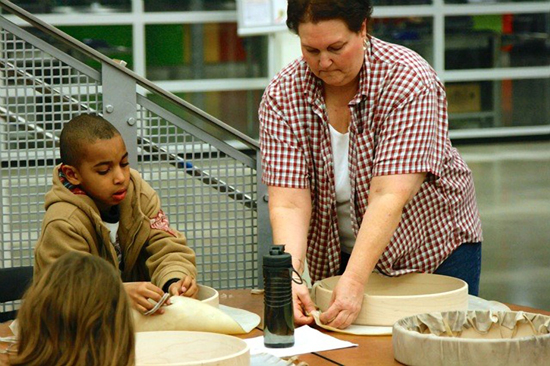
- Courtesy Photo. Margit Moore, a volunteer with Eastside Native American Education Program, helps a young student learn how to make a drum as part of the program’s annual event focusing on Native American culture.
By Shannon Michael, NWNews.com
It has been 30 years since the Eastside Native American Education Program (ENAEP) was formed in 1974 by the Lake Washington School District.
Since the initiation of the Indian Education Act of 1972, the federal government has assisted local school districts in funding educational programs for all Native American, American Indian and Alaskan Native children, according to the LWSD website.
Shortly after forming, the Bellevue and Northshore school districts joined the program that assists Native American, Alaskan Native and American Indian students and their families in grades K-12.
A student, or parent or grandparent must be an enrolled member of a Federally Recognized band or tribe in order to enroll in ENAEP.Families with students in these districts have two opportunities a year to enroll in the program. In the Northshore School District, 89 students and their families are currently enrolled, according to Linda Hoste, Title III director that helps coordinates with the program for Northshore students.
“The biggest benefit we see from students participating in the program is the connection to their native culture. It builds self-esteem, and the academic support gives them success,” Hoste said.
ENAEP offers a wide-ranging selection of activities and resources to participants at the weekly Monday evening meetings held at Lake Washington High School.
Students and families who attend the meetings are offered resources such as homework support, mentoring, referral services for social services, advocacy, test preparation classes, job shadowing opportunities, and at least one major annual event that highlights their native culture.
Overseeing ENAEP is Mary Wilber, a member of the Okanagan Nation. She is the Native American education coordinator for the Lake Washington, Bellevue, and Northshore districts. “On average, we have about 30 students and their families attend the weekly meetings,” she said.
This year’s major cultural event organized by volunteers is drum making, which has been well attended. “Students are learning six to seven traditional songs that they can sing using their drums,” she added. Fifty-seven students and their families have participated in the drum making event, she said.
While homework support is one of the most important priorities at the weekly meetings, so is the “Know the Facts” segment where volunteers teach Native American history not taught in the classroom. “We don’t duplicate, but supplicate what is taught in schools,” Wilber said.
Another component of the program is to guide older students to become mentors to the younger students. “We have former students now in college locally who still come to the meetings to tutor younger students,” Wilber said.
Next up for participants in ENAEP is an indigenous food demonstration on March 31 at 21 Acres in Woodinville. “We are excited to partner with 21 Acres,” Wilber said.
In addition to providing support to students and their families, ENAEP also provides support and training to teachers. They provide curriculum workshops on the Washington State Tribal Sovereignty Program to K-12 social studies teachers as part of a state bill passed in 2005 encouraging all schools to teach Washington State Tribal History in public schools.
Hoste added that they’ve provided cultural awareness training for teachers, as well.
Because ENAEP is federally funded, annual assessments of how the funding is being used to meet the program’s goals is required as part of the annual grant received by the government.
For more information about ENAEP, contact Mary Wilber, MWilber@lwsd.org or (425) 936-1402.
Coming together over KXL
Brian Ward provides the backdrop to the emergence of the Cowboy Indian Alliance.
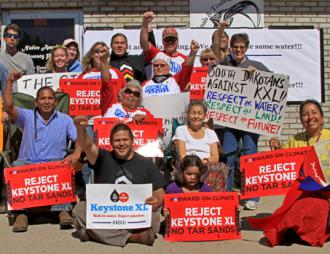
Source: SocialistWorker.org
FOLLOWING IN the footsteps of the nearly 400 students arrested in front of the White House on March 2 for protesting the Keystone XL pipeline is one of the most unlikely coalitions yet to stand for ecological justice.
On April 22–Earth Day–the Cowboy Indian Alliance says it will “ride into Washington, D.C., for the next, and perhaps final, chapter in the fight against Keystone XL.” According to the alliance’s statement at the Reject and Protect website:
On that day, we will set up camp nearby the White House, lighting our fire and burning our sage, and for five days, we will bear proud witness to President Obama’s final decision on Keystone XL, reminding him of the threat this tar sands pipeline poses to our climate, land, water and tribal rights.
As Brianna Elliott writes at the Huffington Post:
This rally gives a voice to the communities that would be most impacted by Keystone XL, and their message is clear–to protect land, water and climate now and for future generations. The Keystone XL would cross several rivers and the Ogallala Aquifer, which would put wildlife, public water supplies and croplands in danger if a spill were to occur, according to the National Wildlife Federation.
– – – – – – – – – – – – – – – –
THIS TYPE of alliance is rare. Ever since the encroachment of settlers onto Native lands, many whites and Native Americans have been at odds, whether over water rights, land rights, hunting rights, etc. Settler expansion laid the foundation for the formation of the U.S. nation state to have access to resources and further expand its interest internationally.
Many of those participating in the Cowboy Indian Alliance are fighting to uphold the protections of the Fort Laramie Treaty of 1851 and 1868. The Lakota (Sioux) signed a document with the U.S. government to create the “Great Sioux Reservation,” to include all of South Dakota west of the Missouri River, including hunting grounds in Northern Nebraska, North Dakota, Wyoming and Montana. The treaty stated that “no white person or persons shall be permitted to settle upon or occupy any portion of the [territory]; or without the consent of the Indians, first had and obtained, to pass through the same.”
The federal government signed the treaty before gold was discovered in the Black Hills in 1871. The Black Hills are the most sacred piece of land to the Lakota. Mining companies disregarded the 1868 treaty and flooded into the area, under the protection of the U.S. Army’s 7th Cavalry commanded by Gen. George Armstrong Custer. The U.S. seized the Black Hills and split up the “Great Sioux Reservation” into six smaller reservations in 1877. This culminated with the Wounded Knee Massacre, in which 150 to 300 Lakota men, women and children were slaughtered by the 7th Cavalry.
Now the Keystone XL pipeline would run across this treaty land. The pipeline would not run directly through any Indian reservations, though it comes within feet of them, and it could contaminate the Ogllala Aquifer, the source of water for the whole region. Tribes such at the Rosebud Sioux Tribe (RST) have taken a formal stand against the pipeline. As the Lakota Voice reported:
The Rosebud Sioux Tribal unanimously passed RST Resolution 2014-29, stating that Tribe “objects to and refuses to sign” the amended Programmatic Agreement, a document imposed upon the Tribe by the Federal Government to attempt to meet legally required consultation requirements. Council Representative Russell Eagle Bear said, “It is our job as the Tribal Council to take action to protect the health and welfare of our people, and this resolution puts the federal government on notice.”
The RST is leading a campaign called Oyate Wahacanka Woecun (“Shield the People”), which will set up encampments along the proposed route to resist construction of the pipeline. Gary Dorr of the Nez Perce Tribe called out the Obama administration about its lack of consultation with tribes on MSNBC’s The Ed Show:
I would ask him to look at his own initiative on consultation and these tribes that are all along from Montana all the way down to Texas. We deserve that consultation, we enjoy a special relationship with the United States as a nation-to-nation government.
Despite the federal government’s renewed interested in getting approval from tribes for the pipeline, it comes late in the game. Last May, 10 Tribal Nations walked out of a meeting with the State Department over this very concern.
Winona LaDuke, an American Indian activist, environmentalist and vice presidential candidate of the Green Party in 1996 and 2000, was frank about what the KXL represented to the Lakota:
Basically, the Lakota, like many other Native people see a big infrastructure project like the KXL pipeline, which moves profits from one corporation to another, across their land, as more than a black snake of the fat taker. It is a threat, and there is no new water.
Even state courts are coming down against the pipeline. In Nebraska, a judge last month sided with three property owners who claimed that the state governor’s decision to agree to the pipeline violated the state’s constitution by taking the decision out of the hands of the public service commission that should to review the pipeline.
– – – – – – – – – – – – – – – –
THOUGH THE Cowboy Indian Alliance is a rare occurrence, it isn’t the first time Natives and non-Natives have come together to protect their water and land. One clear example is the Black Hills Alliance (BHA) that fought back against uranium mining in the late 1970s and early 1980s.
In January 1977–at the same time that the American Indian Movement (AIM) was talking about treaty rights and the Lakota’s rights to the Black Hills at the height of the red power movement–uranium was found in the Blacks Hills. What came to be known as “Custer’s Expedition Part II” began as companies came to drill for profit and to help the U.S. war machine in the midst of the Cold War.
Since the Black Hills is a watershed for much of western South Dakota, Native peoples as well as local ranchers and farmers objected to uranium drilling, because it would pollute and contaminate their drinking water.
This wasn’t only about using land for energy extraction–it was also an attack on Lakota sovereignty, since the U.S. government was willing to sell off mining leases with no contact with the Lakota, much less their consent.
At this time, tensions were high between Native Americans and whites in western South Dakota because of the AIM occupation of Wounded Knee in 1973 and the legacy of assaults on and deaths of Native peoples on the outskirts around reservations.
Bill Means, a prominent AIM member, eventually spoke directly with small groups of ranching families, with the message that if the energy corporations had their way, there would be little water left to fight over. Means said he and other Lakota argued that treaties could be a legal means to challenge the mining. In turn, he came to understand the concerns of ranchers about low cattle prices and contamination from pesticides and herbicides.
Out of these discussions, the Black Hills Alliance (BHA) was founded in 1979, organizing Lakota, ranchers, farmers and local environmental activists together, as the Cowboy Indian Alliance does today. Bruce Ellison, one of the co-founders of the BHA, remembers: “You could feel the tension in the air…ever since white people came [to the region], the corporations have used ignorance to keep the people most in common with each other at each other’s throats. We wanted to avoid that being an available tactic.”
As the organizing continued, people’s ideas started to change. Non-Natives started to see that their struggle was in line with that of the Lakota. Marvin Kammerer was a case in point. His family had been ranching in the Black Hills since the land was stolen from the Lakota. In a New York Times interview, he said:
I’ve read the Fort Laramie Treaty, and it seems pretty simple to me; their claim is justified. There’s no way the Indians are going to get all of that land back, but the state land and the federal land should be returned to them. Out of respect for those people, and for their belief that the hills are sacred ground, I don’t want to be a part of this destruction.
The BHA demanded that any exploration permit had to be voted on by residents in South Dakota, rather than the state government just handing over the leases. As a result of the BHA’s organizing through continuous protest and legal pressure, many corporations were forced to give up their exploration permits. For example, in 1979, Union Carbide’s license from the U.S. Forest Service to dig up Craven Canyon without preparing an environmental impact statement was successfully contested by the BHA.
Uranium mining is still being fought to this day by the people of South Dakota, but the experience of the BHA can guide us to what a multi-racial fight against environmental destruction can look like.
Those who support the Cowboy Indian Alliance’s march to Washington, D.C. to oppose the pipeline can learn from the tradition of the BHA. It is part of the hidden history of struggle that we need to revive in the fights of today.
A version of this article appeared previously at System Change, Not Climate Change.
Mass scallop die off a ‘red flag’ for the world’s oceans, and climate change is to blame
By Jacob Chamberlain. Source: Common Dreams
An increase of acidity in the Pacific Ocean is quickly killing off one of the world’s most beloved shellfish, the scallop, according to a report by the British Columbia Shellfish Grower’s Association.
“By June of 2013, we lost almost 95 per cent of our crops,” Rob Saunders, CEO of Island Scallops in B.C. told Canada’s CTV News.
The cause of this increase in acidity, scientists say, is the exponential burning of fossil fuels for energy and its subsequent pollution. Oceans naturally absorb carbon dioxide, a byproduct of fossil fuel emissions, which causes acidity to rise.
An overdose of carbon in the atmosphere subsequently causes too much acidity in the world’s oceans, Chris Harley, a marine ecologist from the University of British Columbia, told CTV News. Overly acidic water is bad for shellfish, as it impairs them from developing rigid shells. Oyster hatcheries along the West Coast are also experiencing a steep decline,CTV News reports.
“This is a bit of a red flag,” said Harley.
And this red flag has a much bigger impact than one might imagine. “Whenever we see an impact at some level of the food chain, there is a cascading effect at other levels of the food chain,” said Peter Ross, an expert in ocean pollution science.
A recent study warned that ocean acidification is accelerating at a rate unparalleled in the life of the oceans—perhaps the fastest rate in the planet’s existence—which is degrading marine ecosystems on a mass scale.
“The current rate of change is likely to be more than 10 times faster than it has been in any of the evolutionary crises in the earth’s history,” said German marine biologist Hans Poertnerupon the release of a recent study published in the journal Nature.
Ocean acidification has been referred to as the “evil twin” of climate change.
Poertner says that if humanity’s industrial carbon emissions continue with a “business as usual” attitude, levels of acidity in the world’s oceans will be catastrophic.
It’s March, it’s madness, and Indian country has players to watch

By Vince Devlin, Buffalo Post
At the start of this college basketball season, Brent Cahwee wrote about 10 Native American players – well, 11, actually – for fans to keep their eyes on at ndnsports.com.
Now that March Madness is upon the nation, it’s time to remind folks that some of them are still playing. Two of the most notable are sisters Shoni and Jude Schimmel from the Confederated Tribes of the Umatilla Indian Reservation, who play for Louisville – a No. 3 seed in the NCAA women’s basketball tournament.
What hasn’t been said or written about the dynamic duo of sisters that have taken women’s college basketball and Indian country by storm. Shoni, described as a more flashy and “rez” ball style player and Jude, described as a more steady and blue collar player, helped lead the Louisville Cardinals to an appearance in the 2013 women’s national championship game.
(They made) an improbable run through the tournament by beating then-No. 1-ranked Baylor in what was has been called the women’s game of the century. The Lady Cardinals also beat Tennessee and California to reach the championship game, making the sisters the first Native Americans from a reservation to play in the NCAA championship game.
Louisville opens this year’s NCAA tourney against Idaho.
There are others on Cahwee’s list still playing, most notably Bronson Koenig of the Ho-Chunk Nation, a 6-3 freshman point guard at the University of Wisconsin. The Badgers are a No. 2 seed in the NCAA men’s tournament.
One Native star missing out on the rest of March is Marshall Henderson of the Choctaw Nation of Oklahoma, who spent two tumultuous years at the University of Mississippi.
The Running Rebels made waves in last year’s NCAA Tournament, but did not qualify for it, or the NIT, in this, Henderson’s senior season.
Check out all of Cahwee’s Native stars at ndnsports.com.
Through a Survivor’s Eyes: March 20, National Native American HIV/AIDS Awareness Day
PHOENIX—I am Isadore Boni and a member of the San Carlos Apache Tribe in Arizona. Living with HIV has not been easy. A lot of people think you can just take pills, but it’s far greater than that.
I’ve gone through the trenches living on the streets of Phoenix for two years, digging ditches working day-labor at minimum wage. Because of the stigma, I chose to disappear for a while and very rarely communicated with my family. I’ve also dealt with hate-crimes while homeless.
RELATED: National Native American HIV/AIDS Awareness Day: ‘It Means Life’
Isadore Boni: AIDS Stigma Holding Back Progress in Indian Country
Victory at Last: Apache Activist Helps Pass HIV/AIDS Confidentiality Resolution
Native AIDS Survivor Finds Empowerment Through Honesty, Fights for HIV Confidentiality Law
Apache AIDS Survivor Runs Fifth Half-Marathon
I knew this was not what I planned for my life. I am a college graduate from Arizona State University. This was not supposed to happen. Several years later after obtaining housing for people with AIDS my life changed. Going public took me to places I never imagined. I became affiliated with the National Native American AIDS Prevention Center sitting on their Community Advisory Council. It was in 2007 that they began the National Native American AIDS Awareness Day.
With the CDC reporting that Native people have the shortest life-span after infection, I decided to do more than expected. I never had a “job” at an AIDS agency. I did all my fundraising through car-washes at the store I worked as a janitor. More than 80 ASU students would volunteer their time to raise funds. This is how I managed to reach Indian country. My tribal council would not embrace me when I was diagnosed; I expected this, I thought it was because of my sexual orientation as well. I began thinking “if I were straight I’d be embraced by everyone.”
National Native American HIV/AIDS Awareness Day is held on March 20, and every year I do all I can to share my story, even if it’s to homeless people on the streets. This day is about learning the facts of HIV/AIDS, but also to remember those who are living with HIV/AIDS and those who died of complications.
This is not a city problem; it’s a reservation problem too. If our reservations provided education, testing, and linkage to care, perhaps we wouldn’t have the shortest life-span.
Today, after all the years of educating my people, my tribal council has completely embraced me, even passing a confidentiality law. I still do not have a “job” in this field, but I know people like me are needed I am honored to speak for those who are voiceless, advocate for patient rights, and continue to live my life with the knowledge that my Higher Power guides me. Thy Will, not Mine, be Done.
his article was originally published by Wellbound Storytellers. Read more blogs about healthy living written by Natives throughout Indian country at WellboundStorytellers.com.
Read more at http://indiancountrytodaymedianetwork.com/2014/03/20/through-survivors-eyes-march-20-national-native-american-hivaids-awareness-day-154094

